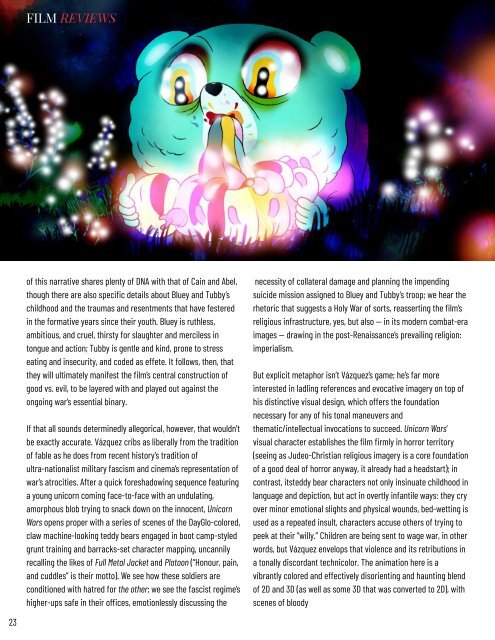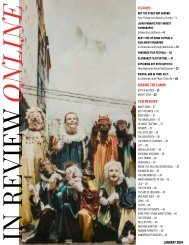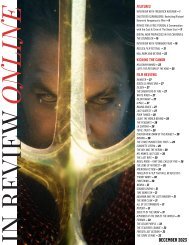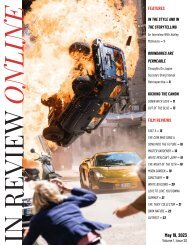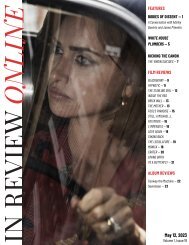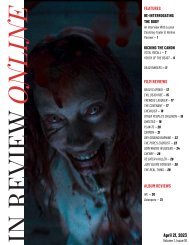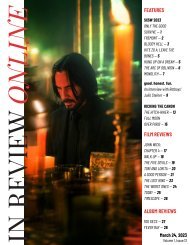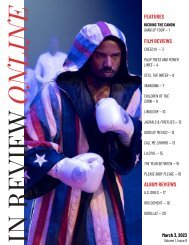InRO Weekly — Volume 1, Issue 10
Create successful ePaper yourself
Turn your PDF publications into a flip-book with our unique Google optimized e-Paper software.
FILM REVIEWS<br />
of this narrative shares plenty of DNA with that of Cain and Abel,<br />
though there are also specific details about Bluey and Tubby’s<br />
childhood and the traumas and resentments that have festered<br />
in the formative years since their youth. Bluey is ruthless,<br />
ambitious, and cruel, thirsty for slaughter and merciless in<br />
tongue and action; Tubby is gentle and kind, prone to stress<br />
eating and insecurity, and coded as effete. It follows, then, that<br />
they will ultimately manifest the film’s central construction of<br />
good vs. evil, to be layered with and played out against the<br />
ongoing war’s essential binary.<br />
If that all sounds determinedly allegorical, however, that wouldn’t<br />
be exactly accurate. Vázquez cribs as liberally from the tradition<br />
of fable as he does from recent history’s tradition of<br />
ultra-nationalist military fascism and cinema’s representation of<br />
war’s atrocities. After a quick foreshadowing sequence featuring<br />
a young unicorn coming face-to-face with an undulating,<br />
amorphous blob trying to snack down on the innocent, Unicorn<br />
Wars opens proper with a series of scenes of the DayGlo-colored,<br />
claw machine-looking teddy bears engaged in boot camp-styled<br />
grunt training and barracks-set character mapping, uncannily<br />
recalling the likes of Full Metal Jacket and Platoon (“Honour, pain,<br />
and cuddles” is their motto). We see how these soldiers are<br />
conditioned with hatred for the other; we see the fascist regime’s<br />
higher-ups safe in their offices, emotionlessly discussing the<br />
necessity of collateral damage and planning the impending<br />
suicide mission assigned to Bluey and Tubby’s troop; we hear the<br />
rhetoric that suggests a Holy War of sorts, reasserting the film’s<br />
religious infrastructure, yes, but also <strong>—</strong> in its modern combat-era<br />
images <strong>—</strong> drawing in the post-Renaissance’s prevailing religion:<br />
imperialism.<br />
But explicit metaphor isn’t Vázquez’s game; he’s far more<br />
interested in ladling references and evocative imagery on top of<br />
his distinctive visual design, which offers the foundation<br />
necessary for any of his tonal maneuvers and<br />
thematic/intellectual invocations to succeed. Unicorn Wars’<br />
visual character establishes the film firmly in horror territory<br />
(seeing as Judeo-Christian religious imagery is a core foundation<br />
of a good deal of horror anyway, it already had a headstart); in<br />
contrast, itsteddy bear characters not only insinuate childhood in<br />
language and depiction, but act in overtly infantile ways: they cry<br />
over minor emotional slights and physical wounds, bed-wetting is<br />
used as a repeated insult, characters accuse others of trying to<br />
peek at their “willy.” Children are being sent to wage war, in other<br />
words, but Vázquez envelops that violence and its retributions in<br />
a tonally discordant technicolor. The animation here is a<br />
vibrantly colored and effectively disorienting and haunting blend<br />
of 2D and 3D (as well as some 3D that was converted to 2D), with<br />
scenes of bloody<br />
23


